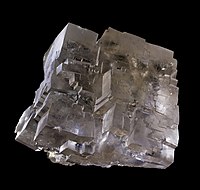
Photo from wikipedia
Abstract The interaction of fluids with rock-forming minerals plays an important role in the chemical evolution of mafic and ultramafic rocks in the lower crust and upper mantle. Recent work… Click to show full abstract
Abstract The interaction of fluids with rock-forming minerals plays an important role in the chemical evolution of mafic and ultramafic rocks in the lower crust and upper mantle. Recent work highlights the importance of salt-rich fluids in element transport in settings such as the mantle wedge above subduction zones and high-grade granulite facies metamorphism. Forsterite (Mg2SiO4), enstatite (MgSiO3) and diopside (CaMgSi2O6) are key rock-forming minerals in these settings in the system CaO-MgO-SiO2. We determined experimentally the solubilities of diopside, enstatite and forsterite in H2O-NaCl fluids at a range of pressures and temperatures. Forsterite solubility was determined at 1 GPa, 800 and 900 °C, in pure H2O and in H2O-NaCl solutions. Forsterite dissolved congruently at nearly all conditions. Its solubility in pure H2O is low, but increases greatly with rising NaCl concentration in the fluid. Enstatite solubility was investigated in H2O-NaCl solutions at 1 GPa, 800 and 900 °C. Enstatite dissolved incongruently to yield forsterite at all conditions. Addition of excess silica led to suppression of forsterite and showed that fluids in equilibrium with enstatite with or without forsterite are strongly enriched in Si relative to Mg, though Mg solubility is significant at high salinity. Diopside solubility was determined in pure H2O at 650–900 °C and 0.7–1.5 GPa, and in H2O-NaCl solutions at 800 °C and 1 GPa, with NaCl concentrations approaching halite saturation. Diopside dissolves incongruently yielding residual forsterite at all conditions investigated. The solubility of diopside in pure H2O increases with increasing pressure, temperature and salinity. Diopside dissolution in H2O-NaCl solutions displays a dependence on fluid salinity similar to that of forsterite and wollastonite. The results of forsterite solubility experiments in H2O-NaCl solutions were used to calculate the compositions of fluid coexisting with enstatite or diopside where forsterite was present. The concentration of solutes coexisting with enstatite decreases with rising NaCl, similar to quartz. In contrast, bulk solutes coexisting with diopside increase with NaCl, similar to wollastonite and forsterite. These patterns imply complexing among rock-forming components and fluid components, that Ca-chloride species are substantially more stable than Mg-chloride species, and that hydrous Na-silicate complexes are important components of deep H2O-NaCl fluids. The results show that salt-bearing brines have substantial metasomatic power and may exert significant control on the chemical evolution of lower crustal and upper mantle mafic and ultramafic rocks.
Journal Title: Geochimica et Cosmochimica Acta
Year Published: 2020
Link to full text (if available)
Share on Social Media: Sign Up to like & get
recommendations!